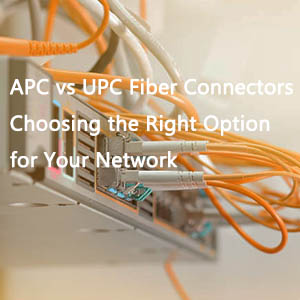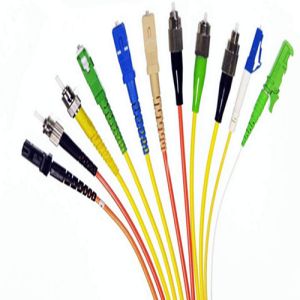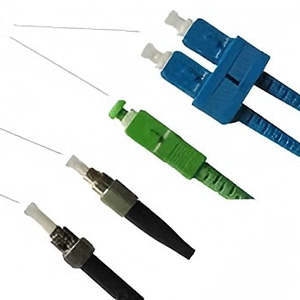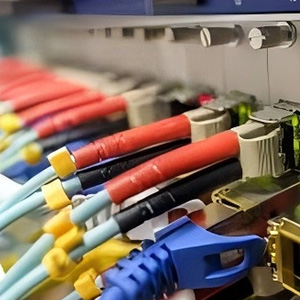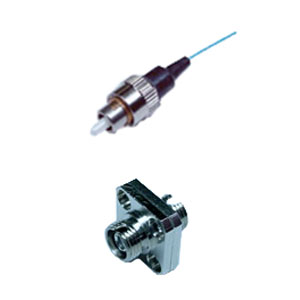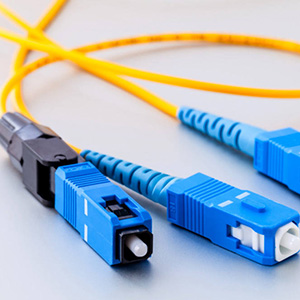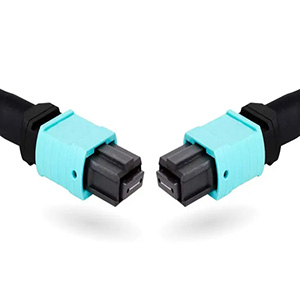Fiber Optic Connectors, available in a myriad of configurations and types, are integral to the functionality of fiber optic cables. They can be classified according to various criteria such as utilization, fiber count, transmission mode, method of transmission, type of transmission media, boot length, polishing type, and termination method.
Utilization: Integration with Adapter Panels
Certain fiber optic connectors like LC, SC, MTP/MPO, and ST require an adapter panel for connection. These Fiber optic connectors are prevalent in settings such as data centers, telecommunications rooms, and corporate networks.
LC Fiber optic Connectors: The Small Form Factor Star
The Lucent Fiber Optic Connectors (LC) is a small form factor (SFF) connector with a 1.25 mm ferrule. Its compact design has garnered significant popularity in data communications, making it ideal for high-density deployments. The LC Fiber Optic Connectors is now the most widely used Fiber Optic Connectors, favored for its efficiency in cabling solutions.
SC Fiber Optic Connectors: A Pioneer in Standardization
The SC Fiber Optic Connectors, chosen initially for the TIA-568 standard, is known for its snap-in mechanism. The “SC” stands for “Square Connector,” reflecting its distinctive shape. With a 2.5 mm ferrule, it’s well-suited for both datacom and telecom applications, including point-to-point and passive optical networks. The SC Fiber Optic Connectors consistent performance has made it a leading choice for polarization-maintaining applications.
MTP/MPO Fiber Optic Connectors: The Multi-Fiber Powerhouse
The MTP/MPO Fiber Optic Connectors sets itself apart as a multi-fiber optic connectors, capable of consolidating 12 to 24 fibers into a single rectangular ferrule. Predominantly used in high-bandwidth parallel optical connections for 40G and 100G networks, these Fiber Optic Connectors come with a complexity that involves considerations of key-up/key-down and male/female configurations.
ST Fiber Optic Connectors: The Pioneering Straight Tip
The Straight Tip (ST) Fiber Optic Connectors, introduced by AT&T, uses a ceramic, spring-loaded 2.5 mm ferrule secured by a half-twist bayonet mount. It’s versatile, serving both long and short-distance applications across various environments, from educational campuses to military operations.
FC Fiber Optic Connectors: The First with a Ceramic Ferrule
The Ferrule Fiber Optic Connectors (FC) was the first to employ a ceramic ferrule. Distinguished by its metallic, screw-type coupling, the FC Fiber Optic Connectors relies on an alignment key and a threaded collet for secure attachment. Despite the complexity in manufacturing and installation, FC connectors are still selected for precision equipment and single-mode fibers, though their prevalence has waned with the advent of SC and LC connectors.

MT-RJ Fiber Optic Connectors: The Duplex Fiber Optic Connectors with Pins
The Mechanical Transfer Registered Jack (MT-RJ) Fiber Optic Connectors is a duplex Fiber Optic Connectors that employs metal guide pins for precise alignment. Its plastic housing and compact size offer a cost-effective and dense solution for electronic and cable management hardware.
MU Fiber Optic Connectors: The Miniature with a Self-Retentive Mechanism
The MU Fiber Optic Connectors, a miniature version of the SC with a 1.25 mm ferrule, features a simple push-pull design. It’s tailored for compact backplane applications and is available for customization to meet high power requirements.
DIN Fiber Optic Connectors: The Round Fiber Optic Connectors with Circular Pins
The DIN Fiber Optic Connectors, with its circular pin arrangement, is used in a variety of devices, from PC keyboards to MIDI instruments. Its full-sized version typically ranges from three to 14 pins, each with a diameter of 13.2 millimeters.
E2000 Fiber Optic Connectors: The Safe and Powerful Push-Pull Fiber Optic Connectors
The E2000 Fiber Optic Connectors offers a push-pull mechanism with an automatic metal shutter for dust and laser beam protection. Its one-piece design simplifies termination, making it suitable for high safety and power applications.
Quick Connections without Adapter Panels
Fiber Optic Connectors like Rosenberger’s Q-RMC and NEX10 stand out for their push-pull quick locking mechanism, allowing for swift connections without the need for an adapter panel. These Fiber Optic Connectors are engineered for harsh environments.
Rosenberger Q-RMC Fiber Optic Connectors: The Robust Industrial Choice
The Q-RMC Fiber Optic Connectors, with its multi-fiber MT ferrule accommodating 24 fiber cores, exemplifies a small form factor Fiber Optic Connectors with a push-pull mechanism. It meets IP67 protection standards, offering waterproof, dustproof, and corrosion-resistant properties. With an operational temperature range of -40 to 80℃, the Q-RMC connector is ideal for industrial, mining, and mobile communication applications.
Rosenberger NEX10 Connector: The Outdoor-Ready Compact Connector
The NEX10 connector, designed for outdoor use, combines a compact size with waterproof, dustproof, and anti-corrosion features. It supports both screw-type and push-pull locking mechanisms, facilitating tool-less installation and removal. The NEX10 connector is finding its place in industries, mining fields, and in-building architectures.

Customization and Versatility
Both Q-RMC and NEX10 connectors are available in single mode and multimode versions, with options to customize the optical fiber type and cable jacket according to specific needs.
Fiber Count and Mode: Simplex, Duplex, Single, and Multimode
Understanding the difference between simplex and duplex connectors, as well as single mode and multimode fibers, is crucial for selecting the right connector for your application. Simplex connectors facilitate one-way transmission, while duplex connectors allow for bidirectional communication. Single mode fibers transmit a single light mode, whereas multimode fibers support multiple modes simultaneously.

Boot Length and Polish: Tailoring to Specific Needs
The choice between standard boot and short boot connectors, as well as the type of polish (PC, UPC, APC), depends on the specific requirements of the installation environment and the desired performance characteristics.
Termination: Field-Terminated vs. Pre-Terminated
Field termination requires on-site preparation and installation by skilled technicians, while pre-terminated solutions offer the convenience of factory-installed connectors, ensuring precision and ease of installation.
Frequently Asked Questions
Can single mode connectors be used on multimode cables? Yes, but multimode connectors are not suitable for single mode cables.
If you have an SC connector and need an LC type, consider purchasing an SC-SC coupler and a pre-terminated SC to LC patch cable. Adapters such as LC-LC or LC-SC are also available.
Market Overview
The prevalent types of fiber optic connectors in the market include LC, SC, MTP/MPO, ST, and FC. The LC connector, with its compact size and high performance, is often the top choice. For high-density data transmissions, MTP/MPO connectors are gaining traction.


